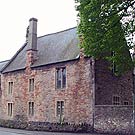Guildhall

Base layers
Data layers

Venue Type & Location
Site Name: Guildhall
Location: Wells
County: Somerset
Location Type: Town - in town at determined location
Overview
Sometimes called the 'almshouse hall,' the medieval guildhall was erected on the S side of Chamberlain Street as the western extension of the almshouses built at the same time. The churchyard of St Cuthbert's Church lies adjacent to the S of the almshouses.
Performance History
Although few civic account books survive from the period, 3 payments in the mid-16th c. indicate that the city hosted touring entertainers. The common hall would have been the probable venue for performances before the mayor.
Current Status
Continuing in use as part of the almshouse now known as Bubwith House, a residence for those in need.
History of the Venue
1436 Guildhall erected for the use of the city and paid for by a legacy from Bishop Bubwith (Parker, Architectural Antiquities of Wells 69).
1614 Gabled wing extension to the almshouses added to the S.
1779 New town hall built on a different site in the marketplace.
18xx Hall divided, one section used to increase accommodation for the almshouse and the other used for meetings of the trustees.
1884 2 additional wings added at right angles to the S end of the guildhall to 'take the place of the almshouses built in accordance with Bishop Still's will A.D. 1614' (wall plaque).
Record Source
REED Somerset 1.257
Bibliographic Sources
-
Aston, Michael, and Roger Leech. Historic Towns in Somerset: Archaeology and Planning. Publications of the Committee for Rescue Archaeology in Avon, Gloucestershire & Somerset. Gloucester: Sabra Publications, 1977.
-
Department of the Environment. List of Buildings of Special Architectural or Historic Interest. Np: Npub, nd.
-
Meek, Marion. The Book of Wells. Buckingham: Barracuda Books, 1980.
-
Parker, John Henry. The Architectural Antiquities of the City of Wells. Oxford: James Parker, 1866.
-
Pevsner, Nikolaus. North Somerset and Bristol. The Buildings of England. Harmondsworth, Midd: Penguin Books, 1973.
-
Simes, William. A Plan of the City of Wells. London: William Simes, 1735.





